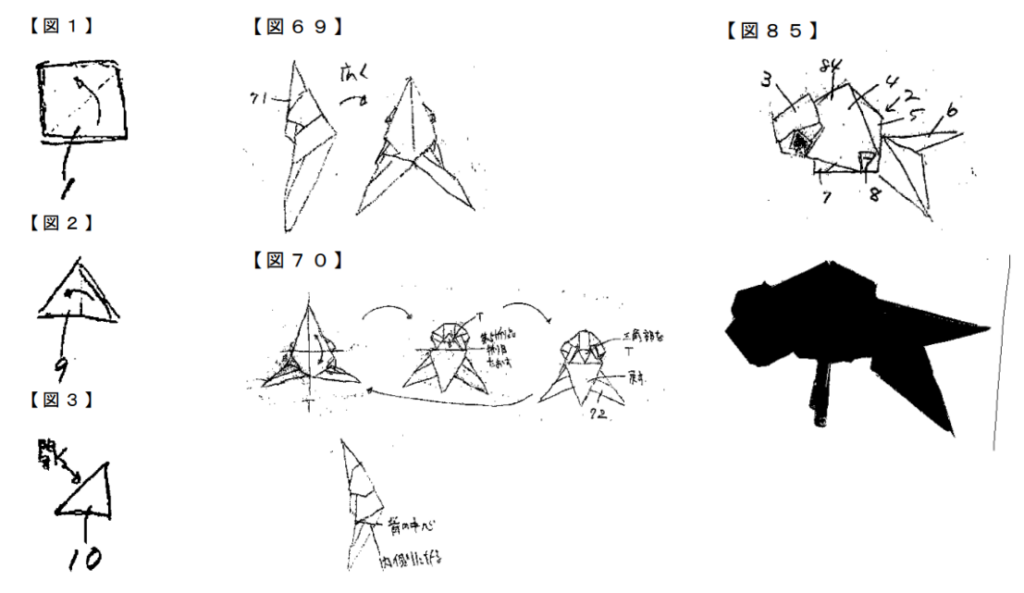
- Overview of the Patent Drawing
- Patent Insight 1: Step-by-Step Folding Instructions for a Complex Model
- Patent Insight 2: Use of Geometric Folding Techniques
- Patent Insight 3: Potential Application for Artistic or Educational Purposes
- Patent Attorney’s Thoughts
- Keywords
- Application of the Technology: “Origami-Based Emotional Diagnostics Sheet”
Overview of the Patent Drawing
The illustrations depict a series of steps for folding an origami model, starting from a square sheet of paper (Figure 1) and progressing through various intermediate forms (Figures 2, 3, 69, 70, 85) to create a complex shape. The figures show a combination of traditional origami techniques, including folding, creasing, and forming triangular and other geometric shapes. The final silhouette (Figure 85) suggests a bird-like or fish-like structure with distinctive pointed features and an appendage.
Patent Insight 1: Step-by-Step Folding Instructions for a Complex Model
The diagrams illustrate the folding process in a sequential manner, which is essential for guiding the user through the creation of a complex origami model. Each step adds layers and details to the form, transforming the initial simple shapes into a sophisticated structure. The step-by-step approach is typical of origami instruction, allowing even intricate designs to be broken down into manageable parts for the folder.
Patent Insight 2: Use of Geometric Folding Techniques
The illustrations highlight the use of geometric folds, such as triangular and kite-shaped creases, which are common in origami to achieve complex forms. The progression through various geometric shapes (e.g., Figures 2, 3, 70) shows how these techniques can create structural depth and texture in the final model. This approach allows for intricate designs while maintaining the integrity of the original paper without cutting.
Patent Insight 3: Potential Application for Artistic or Educational Purposes
The origami model depicted could serve both artistic and educational purposes. As an art form, it provides a creative way to explore paper folding techniques, resulting in a decorative or sculptural piece. Educationally, the folding process can help develop spatial awareness, fine motor skills, and an understanding of geometry, making it suitable for use in classrooms or workshops.
Patent Attorney’s Thoughts
Upon reviewing the patent drawing for the “Origami Folding Process for Creating a Complex Paper Model,” I am deeply impressed by the intricacy and artistic potential of origami.
The diagrams meticulously illustrate the transformation from a simple square sheet to a complex, three-dimensional form, utilizing geometric folds such as triangles and kite shapes.
The final model, resembling a bird or fish, showcases the remarkable possibilities achievable with a single sheet of paper.
This origami process not only serves as an art form but also holds educational value, aiding in the development of spatial awareness and fine motor skills.
Keywords
origami, paper folding, geometric folding, step-by-step instructions, complex origami, educational origami, artistic paper model
Application of the Technology: “Origami-Based Emotional Diagnostics Sheet”
Purpose
By adapting the origami folding process for complex paper models, create an “Origami-Based Emotional Diagnostics Sheet”—a psychological self-assessment tool that changes shape (and meaning) as the user folds it. Like a paper Rorschach test meets fortune-telling, but smarter and slightly more ridiculous.
System Components
- Multi-Step Folding Sheet: A specially designed paper sheet printed with color-coded zones, emotional cues, and fold markers. Each fold alters its meaning, directing the user through a branching psychological journey.
- Mood Mapping Symbols: Embedded icons (smiley, thundercloud, void spiral, etc.) appear as the paper is folded, creating a narrative of the user’s inner emotional labyrinth.
- AI-Powered Folding App (Optional): A companion app that uses the smartphone camera to track your folds and dramatically interpret your progress: “You’ve folded into Anxiety Level 3: Existential Wobble.”
- “Reset My Feelings” Tab: If the final folded form turns out to be an origami gremlin of despair, users can pull a perforated “emergency rip tab” to unfold the entire thing and start over—emotionally and literally.
- Therapeutic Confetti Pocket: Hidden within the folds is a tiny packet of biodegradable confetti. When unfolded correctly, it bursts open like a party popper of catharsis.
Operational Flow
- Choose a Starting Mood: User selects a keyword or emotion to begin (e.g., “meh,” “overstimulated,” or “burned out with mild optimism”).
- Follow the Folding Steps: Each fold asks the user to reflect or answer a question: “What would your 8-year-old self yell at you right now?” or “Fold toward your unfulfilled dreams.”
- Reveal the Origami Result: The final model might resemble a swan (peaceful), a kraken (emotional overload), or a melting chair (…interpretation needed).
- App Interpretation (if enabled): The app delivers your “emotional blueprint” based on fold pattern and symbol exposure, perhaps concluding: “Today, you are 63% Leaf in the Wind.”
- Reset, Reflect, Repeat: Rip the reset tab. Confetti flies. You laugh. You cry. You fold again.
This system lets you literally fold your emotions, confront them, and maybe throw a little confetti at your own existential drama.
Disclaimer: This content is an AI-generated reinterpretation based on a patent drawing.
It is provided for educational and cultural purposes only, and not as legal advice.



